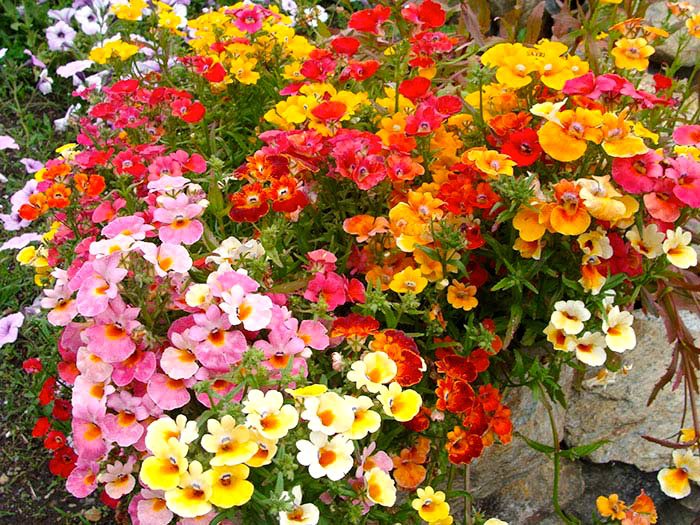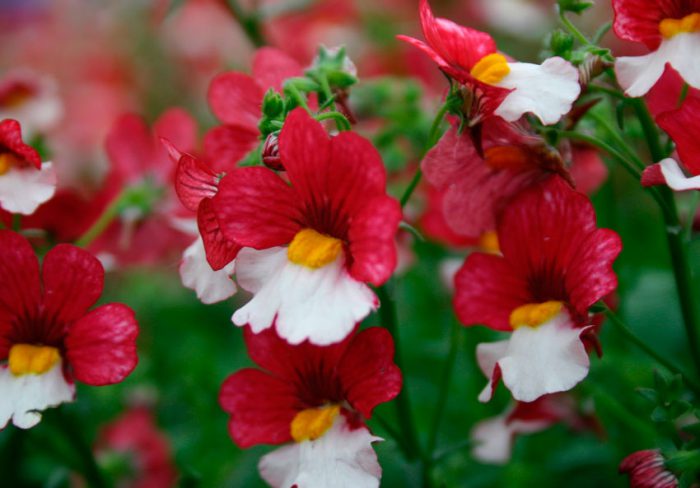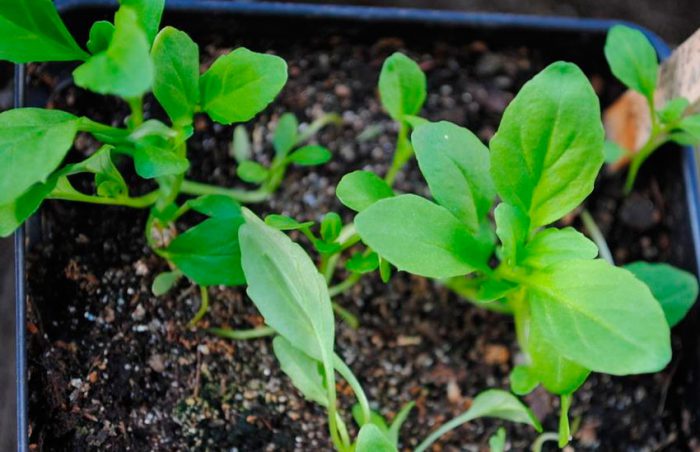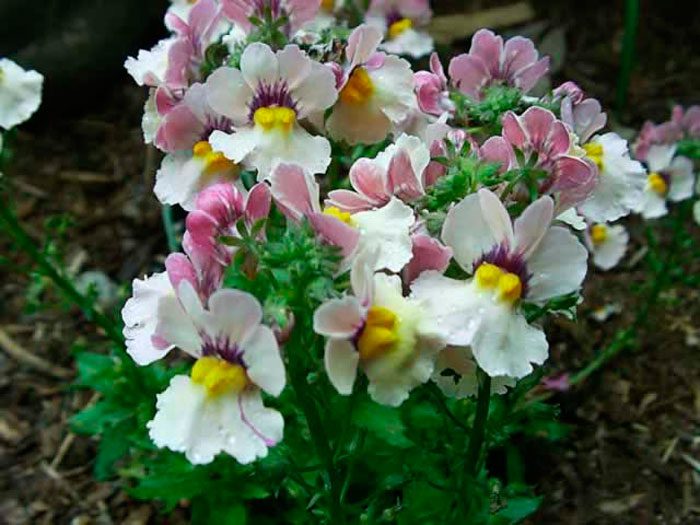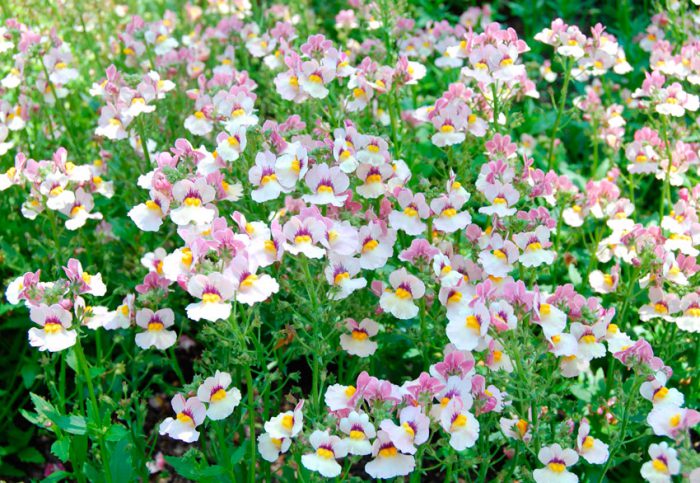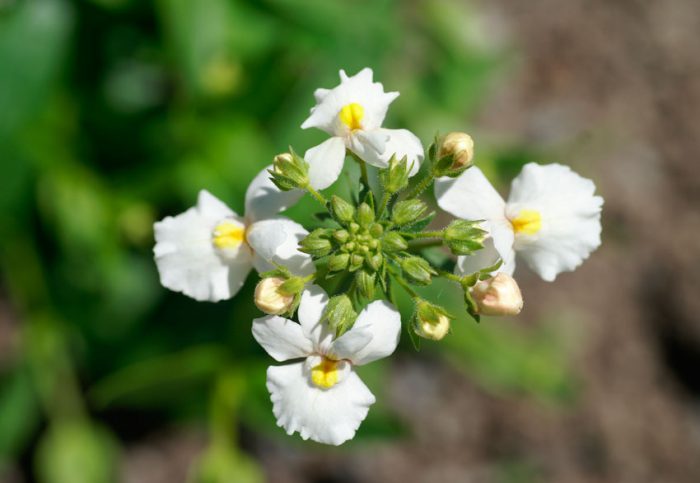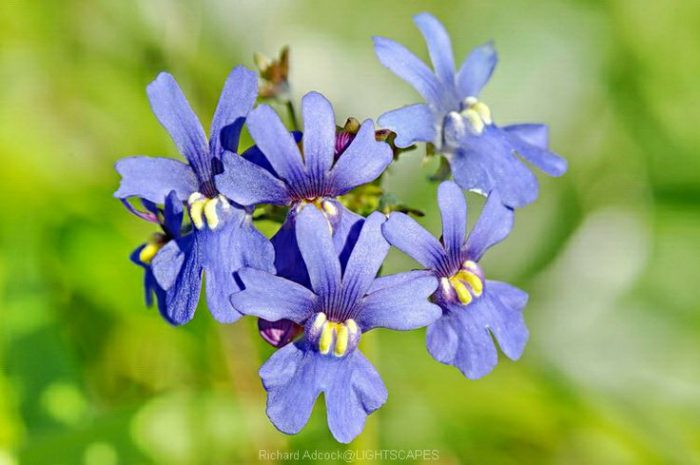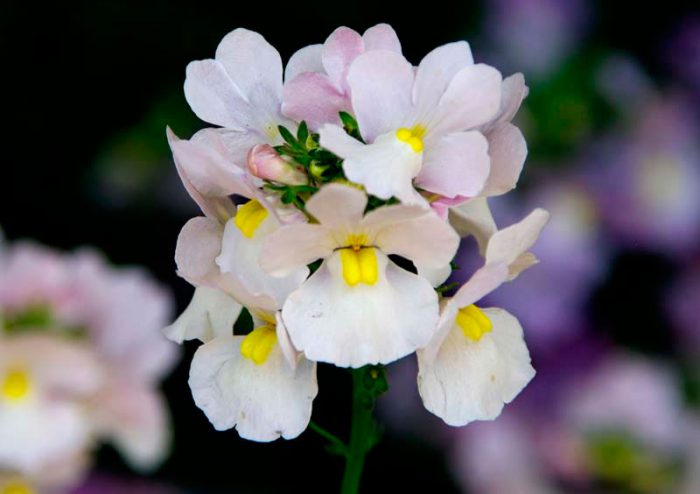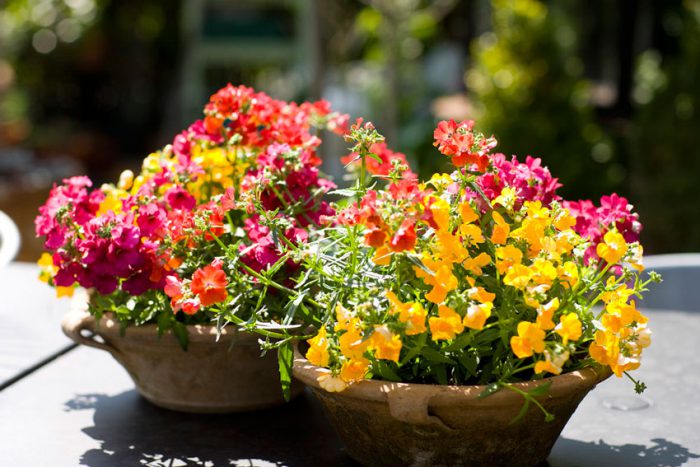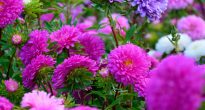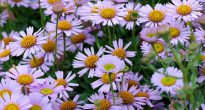Nemesia (Nemesia) is a member of the Norich family. This genus is represented by shrubs and annuals, as well as perennial herbaceous plants. It unites about 50 species, with most of them found in South Africa, such plants prefer to grow in coastal areas and shrubs. This flower was named after Nemesis, the Greek goddess of retribution.
Content
Features of nemesia
The height of the nemesia bush can vary from 0.3 to 0.6 m. There is sometimes pubescence on the surface of the branched tetrahedral shoots. Over time, the stems bend due to the relatively heavy inflorescences and opposite leaf plates of a lanceolate or linear shape with a serrated edge. There are a large number of axillary flowers, which can be solitary or part of the apical inflorescences. The flowers include a tubular corolla with lip-shaped bends: the lower one is dicotyledonous, and the upper one is four-lobed. Flowers can be painted in various colors. The fruit is a capsule, inside of which there are many elongated black seeds, located in light white seedlings. These seeds remain viable for 2 years.
The types of nemesia cultivated by gardeners are both annual and perennial, but in the middle latitudes this plant is grown only as an annual.
Growing nemesia from seeds
Sowing seedlings
Nemesia can be propagated by seed, as well as vegetative: dividing the bush and cuttings. When dividing a bush, its long roots are often severely injured, as a result, the divisions do not take root well. Experienced gardeners recommend propagating such a plant by seeds, or rather, growing it through seedlings.
The seeds can be purchased at the store or collected by yourself. They are sown for seedlings in the last days of March. To do this, use containers for seedlings, which are filled with a moisture-absorbing loose soil mixture intended for flower crops, you can also use sand mixed with peat. A snow layer is laid on top of the substrate, on which the seeds will need to be sown.The fact is that they are very small and have a dark color, so it is much easier to distribute them evenly on a white background. The container must be covered with foil or glass and removed to a well-lit, warm (about 20 degrees) place. Remember to ventilate your crops every day. The first seedlings can be seen after 1.5–2 weeks.
Growing seedlings
When the seedlings begin to appear in large quantities, the shelter is removed, and the container will need to be rearranged to a place with bright, but diffused lighting, at this stage the plants need a coolness of 8 to 10 degrees. If everything is done correctly, it will be possible to avoid pulling out the seedlings. After 7 days from the moment the seedlings appear, they need to be fed by watering with a weak solution of complex fertilizer. Water the plant regularly and remember to gently loosen the surface of the substrate from time to time. After 20-30 days from the moment of sowing, when the plants begin to form 2 or 3 real leaves, it will be necessary to pick them in individual pots or cups, while the seedlings are rearranged to a place with an air temperature of 13 degrees. The soil mixture in the cups should not dry out. Hardening of seedlings begins half a month before transplanting it into open ground.
Growing nemesia at home
As a rule, only nemesia seedlings are grown in room conditions. Then they plant it in open soil, and if you wish, you can move the containers with flowers to the balcony or veranda. How can you decorate a veranda, balcony or terrace with nemesia? In the event that you do not plan to plant such a plant in open ground, then you can sow seeds already in February. Sowing seeds and caring for plants should be exactly the same as when growing seedlings. However, during a pick, flower pots or containers are used instead of cups. When it gets warm outside, nemesia is transferred to the veranda, balcony or terrace.
Planting nemesia in open ground
What time to plant
Transplanting seedlings into open soil is carried out only after there is no threat of night frosts, and the soil warms up well. As a rule, this time falls on the last days of May or the first days of June. For planting, you should choose a ventilated, well-lit, open area. The soil should be moist, well-drained, slightly acidic or neutral. As for the fertility of the soil, it should be medium. This plant can be grown in small lace penumbra.
Landing features
Before you start planting seedlings in open soil, you should prepare the holes. Their size should be such that they can easily accommodate the entire contents of the pot (both the earthen ball and the root system). A distance of 0.2–0.3 m should be kept between the bushes, as they may fall apart a little. When the plants are planted and the holes are sealed, the area needs to be well watered. After the liquid is completely absorbed into the soil, its surface will need to be covered with a layer of mulch, this can prevent the soil from drying out too quickly. The flowering of such a plant can be seen in the last days of June, or the first in July.
Nemesia care
There is nothing difficult in caring for nemesia. To make the bushes very lush, you should systematically pinch the tops of their stems. Throughout the season, the plant must be provided with timely watering, especially during dry periods, as well as regular weeding and loosening of the soil surface around the bushes.
During the season, nemesia will need to be fed 2 or 3 times; for this, a complex mineral fertilizer is used, for example, Kemiru-Lux. Also, this plant responds well to feeding with organic fertilizers.
Pests and diseases
Since such a plant is moisture-loving, it is very often affected by fungal diseases.In order to prevent such nemesia diseases, it is necessary to provide moderate watering, while the topsoil must necessarily dry out. A diseased specimen must be sprayed with a solution of a fungicidal preparation.
Spider mites can settle on such a plant, which suck the vegetable sap from the bush. You can find out that a plant is infected by the presence of a thin and very sticky cobweb on it, as well as by drying and dying leaf plates. If you notice the first signs of damage to the bush, then immediately spray it and the surface of the soil near it with a solution of Aktellik, Fitoverm, Akarin or Karate, you can also use other acaricides.
After flowering
After the first wave of flowering comes to an end, it is imperative to cut off the ends of the stems, with wilting inflorescences located on them. And if you take care of nemesia correctly, then soon new shoots will grow from the leaf sinuses, which will bloom again.
Types and varieties of nemesia with photos and names
Among the many types of nemesia, there are those that are ideal for decorating balconies, and there are those that should be grown outdoors. The most popular among gardeners are the types and varieties described below.
Lush nemesia (Nemesia floribunda)
The height of the bushes is about 0.4 m. At the tops of the stems there are small delicate flowers of a light blue color. This species is still not very popular in gardening today, but every year it can be found in gardens more and more often.
Nemesia multi-colored (Nemesia versicolor)
This annual is a South African species. Thin, highly branched shoots in height can reach 0.25 m. Flowers are small. Thanks to this plant, a huge number of hybrids were born. Most popular varieties:
- Blue Bird... The color of the flowers is deep blue, and there is a spot of white or yellow on the lip.
- Edelblau... The color of the flowers is similar to forget-me-not.
Goiter nemesia (Nemesia strumosa)
The height of this highly branched annual plant varies from 0.35 to 0.4 m. The upper leaf plates are linear, and the lower sessile ones are oval. The shape of the flowers is irregular, they are swollen, do not have spurs and have a drooping throat, reach 2.5 cm in diameter. They can be colored pink, yellow, red or orange, there are varieties with a variegated color. Cultivated since 1892 The most popular varieties:
- Aurora... The height of the bush is about 0.3 m. Large flowers have a scarlet-white color.
- Fanfair... The color of the flowers is yellow and cream.
- Sparklerfrom. Flowers are two or three colors.
- Fire King... The bush reaches a height of 0.3 m, and it is decorated with flowers of a fiery red color.
- Nashinel Ensign... Quite a popular variety has a white-red color of flowers.
Nemesia hybrid (Nemesia hybrida)
This species includes all hybrids obtained by crossing the multicolored nemesia and goiter nemesia. Most often, the height of such annual plants does not exceed 0.3–0.6 m. Elongated, almost lanceolate leaf plates are crenate along the edge. Large (about 20 mm in diameter) irregular flowers with a two-lipped corolla are part of the apical racemes. This type in specialized stores can be purchased, as a rule, only in mixed varieties, while their main difference is the height of the bushes:
- Triumph... The height of the bushes is about 0.15 m, the flowers are painted in different colors.
- Carnival... Bushes reach a height of 0.18–0.2 m, the color of the inflorescences is varied.
You can also purchase individual varieties, the most popular of which are:
- Robe of the King (Cardinal)... The lush-flowering plant is adorned with flowers with long spurs, painted in a deep blue color. The central part of the corolla is white, and a blue border runs along the edge of the petals.
- Tumbelina... This variety is new. Bushes from 0.15 to 0.2 m high are decorated with bluish lavender flowers, the diameter of which is 30 mm.
Sanzatiya (ampelous nemesia) is an interspecific triploid hybrid. It was born in 2009 thanks to German breeders who crossed an annual and perennial nemesia. At the moment, there are only 8 ampel varieties. Their color is similar to exotic fruits, which influenced the choice of their names: Coconut, Blackberry, Pineapple, Cranberry, Lemon, Peach, Banana and Mango. At the same time, only varieties belong to ampelous: Coconut, Pineapple, Lemon, Banana and Cranberry, the rest of the varieties have erect peduncles.

